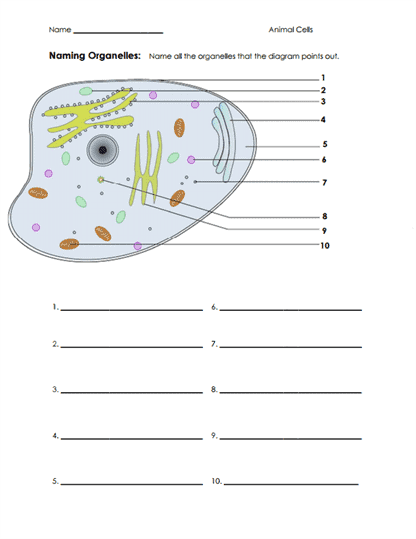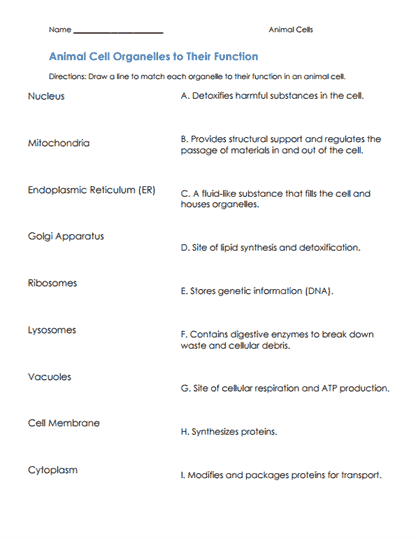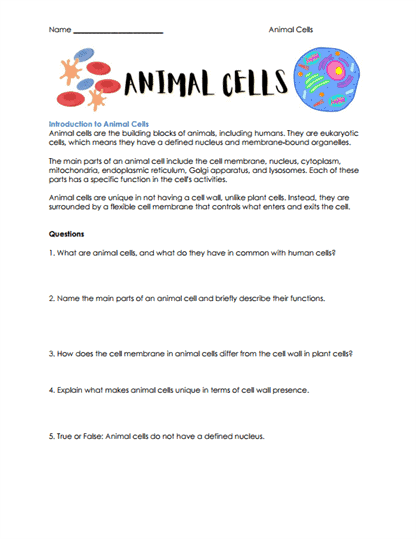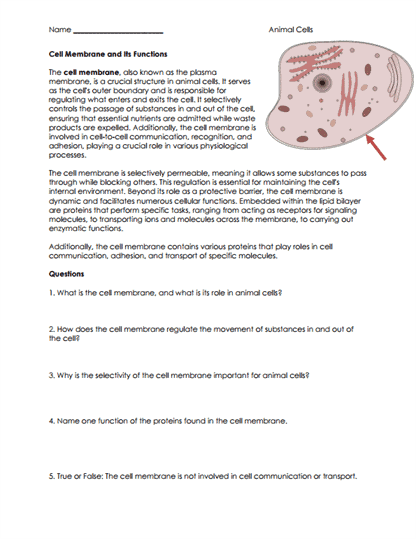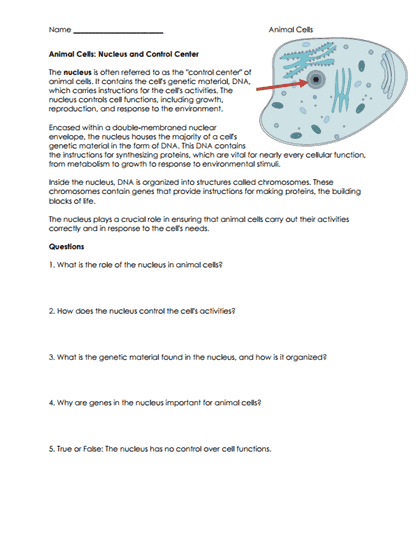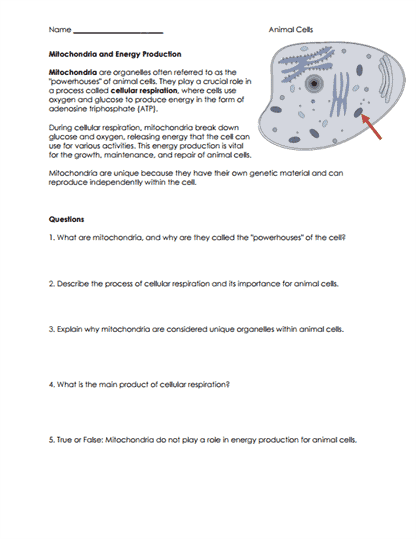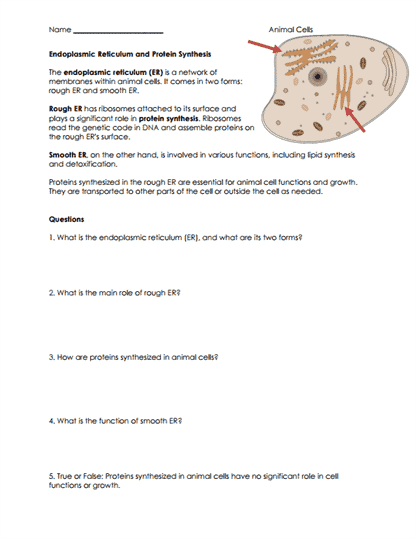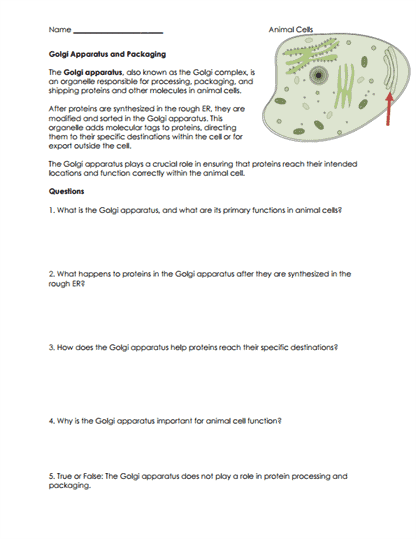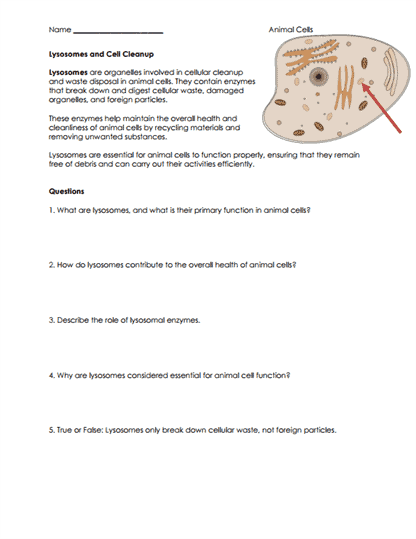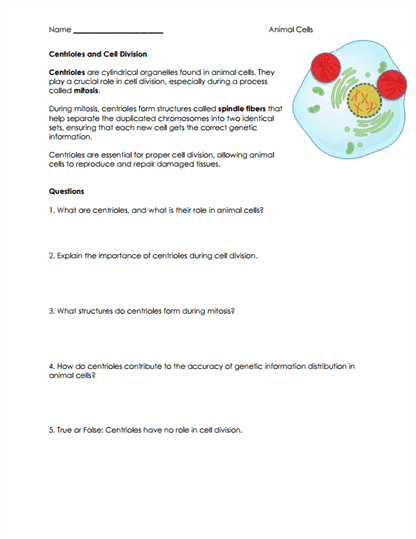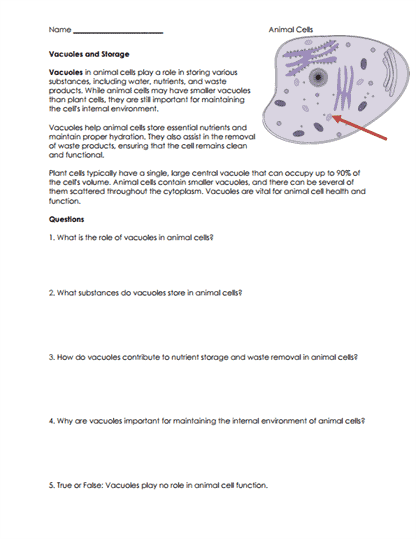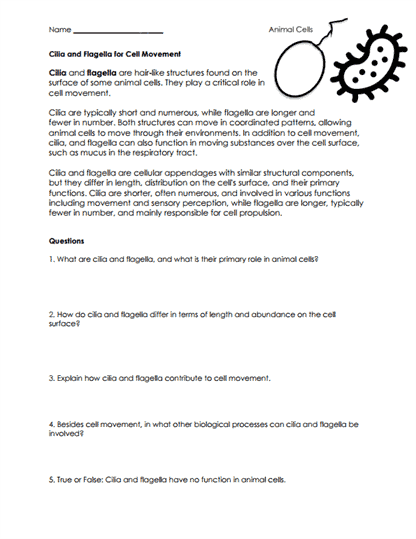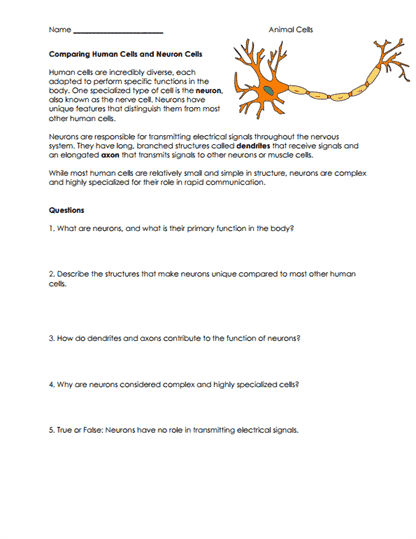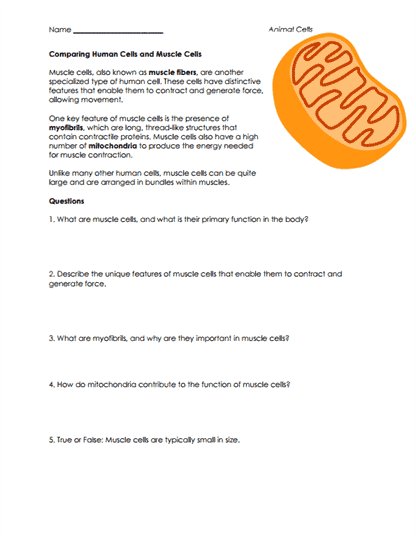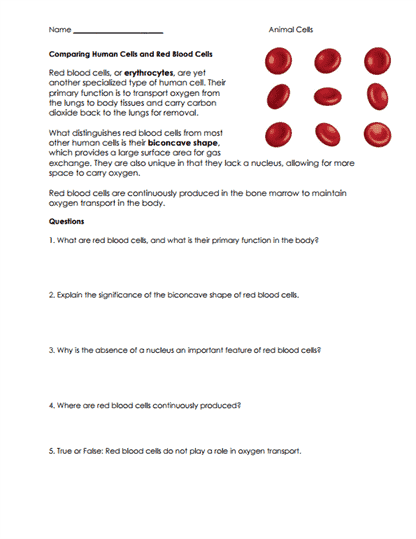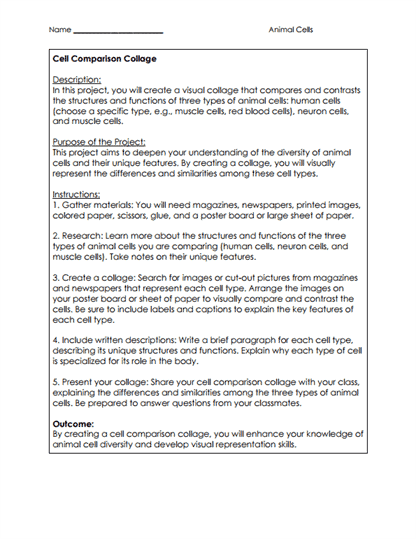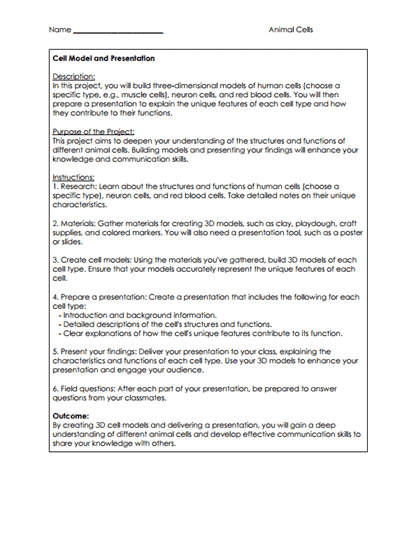Animal Cells Worksheets
About These 15 Worksheets
This series of worksheets offers a comprehensive approach to enhancing students’ understanding of the intricate structure and function of animal cells. Through a series of diverse activities and question-based exercises, students are not only exposed to the fundamental concepts of cell biology but are also encouraged to delve deeper into how these concepts interconnect within the broader biological system. By focusing on both the theoretical and practical aspects of cell functions, the worksheets aim to build a robust foundation that will serve students in their future studies in biology and related sciences.
The worksheets emphasize critical biological components, particularly the organelles, such as the nucleus, mitochondria, endoplasmic reticulum, Golgi apparatus, and lysosomes. Students are challenged to go beyond mere identification of these organelles, fostering a more profound understanding of their specific roles and how they contribute to the cell’s overall functionality. This approach highlights the importance of each organelle, not as an isolated entity, but as part of a coordinated system that maintains cellular health and ensures the proper execution of essential cellular processes.
The focus on real-world biological contexts encourages students to see the relevance of cellular biology in everyday life. For instance, understanding how mitochondria generate energy or how lysosomes break down waste materials can lead to a deeper appreciation of how these processes relate to overall health, disease, and even the function of entire organisms. This application of knowledge transforms the learning experience from rote memorization to an engaging exploration of biology’s practical significance.
A key aspect of the worksheets is their ability to cultivate critical thinking skills. Through questions that ask students to explain the function of the nucleus in regulating cellular activities or differentiate between the roles of smooth and rough endoplasmic reticulum, the worksheets promote analytical thinking. These questions challenge students to not only recall information but to synthesize it, drawing connections between structure and function, cause and effect, and the implications for cellular health.
Comparative tasks further deepen this critical engagement. By asking students to compare animal cells to other cell types, such as plant cells or specialized cells like neurons, the worksheets encourage a broader perspective. This comparative analysis is crucial for understanding the diversity and specialization of cells across different organisms and tissues. It also highlights the adaptability of life, as different cells evolve distinct structures to perform specific functions-like the long, branched structure of neurons for transmitting signals or the energy-intensive mitochondria in muscle cells that support movement.
These worksheets help students develop the ability to apply knowledge at a higher cognitive level. For example, answering questions about how organelles contribute to processes like energy production, protein synthesis, or waste management encourages students to think about cells as dynamic, living systems. Such inquiry-based learning fosters not only comprehension but curiosity, inviting students to consider how the disruption of these processes might lead to disease or how they could be harnessed in biotechnology or medicine.
By engaging students in activities that require both factual understanding and deep analytical thinking, the worksheets aim to instill a lasting comprehension of biological processes that extend far beyond the classroom. This type of educational approach ensures that students not only grasp the intricacies of animal cells but also develop the skills necessary to apply this knowledge in real-world contexts, from understanding health and disease to exploring future scientific endeavors.
Types of Exercises
The types of exercises presented include labeling diagrams, matching organelles to functions, answering structured questions based on given texts, and engaging in true or false assessments to clarify misconceptions. These activities aim to build students’ foundational knowledge, develop their ability to reason through biological processes, and enhance their critical thinking skills regarding the functional significance of animal cells in living organisms. Through this structured and varied approach, the collection provides a comprehensive exploration of animal cell biology.
Labeling and Identification – Labeling exercises are fundamental components of animal cell worksheets. These activities require students to identify and label the different organelles and structures within an animal cell.
Descriptive Questions – These exercises require students to provide written descriptions of organelles and their functions. For instance, students might be asked to explain the role of the nucleus in controlling cellular activities or describe how mitochondria produce energy through cellular respiration. These questions promote a deeper understanding of cell functions.
Organelle Reading Comprehension – These worksheets provide a short, informative text that describes the different organelles-such as the nucleus, mitochondria, endoplasmic reticulum, Golgi apparatus, lysosomes, and others-explaining what each part does to support the cell’s overall function. After reading the passage, students are asked to answer short-answer questions that test their understanding of each organelle, encouraging them to recall details, make connections, and demonstrate comprehension of how these cell parts work together to keep the cell functioning properly
Critical Thinking and Application – These exercises encourage students to apply their knowledge of animal cells to real-world scenarios or hypothetical situations. For instance, students may be presented with a problem related to cell biology and asked to propose solutions or predict the consequences of specific cellular processes.
Assessment Questions – At the end of a worksheet or as part of a quiz or test, students may encounter assessment questions that gauge their overall understanding of animal cell biology. These questions can be multiple-choice, short-answer, or essay-style, depending on the level of complexity and the learning objectives.
These worksheets encompass a wide range of exercises and activities, from labeling and descriptive questions to comparative analysis, crossword puzzles, and critical thinking scenarios. By engaging students in active learning, promoting critical thinking, and reinforcing core concepts, animal cell worksheets play a crucial role in enhancing students’ understanding of cell biology, which is fundamental to their grasp of broader biological concepts and the workings of living organisms.
What Are Animal Cells?
Animal cells are the fundamental units of life for all animals, including humans. These eukaryotic cells are highly complex, containing a well-defined nucleus and various membrane-bound organelles that work together to carry out essential functions. These cells serve as the foundation for every process that sustains life-from growth and reproduction to maintaining the body’s functionality. The intricate design and coordination within each animal cell allow organisms to survive, adapt, and respond to their environment in remarkable ways.
At the heart of each animal cell lies a sophisticated system of organelles that perform specific roles. The nucleus serves as the control center, housing genetic material and directing cellular activities. Mitochondria generate the energy necessary for these activities, while ribosomes and the endoplasmic reticulum manage protein synthesis and transport. These organelles, among others, form an organized structure that ensures the cell can support growth, repair, and metabolic processes essential for the organism’s survival.
Understanding the biology of animal cells is critical to unlocking broader insights into life sciences. These cells are the primary focus of fields like genetics, medicine, and biotechnology, where advancements often stem from studying cellular functions and processes. The study of animal cells provides the foundational knowledge necessary to develop life-saving medical treatments, explore genetic manipulation, and improve agricultural practices, making it one of the most impactful areas of research in modern science.
Every living organism, from the smallest insect to the largest mammal, relies on the function of animal cells. These cells, though invisible to the naked eye, carry out vital tasks such as energy production, cellular communication, and reproduction. Their organization and complexity are what enable animals to grow, repair tissues, and adapt to the ever-changing environment. Exploring animal cells allows students to understand the fundamental mechanics of life and opens the door to deeper insights into how organisms operate.
The importance of animal cell biology cannot be overstated. This knowledge forms the basis for advancements across multiple scientific disciplines. It empowers students and researchers to connect cellular functions with larger biological systems and to apply that understanding in real-world contexts. From health sciences to technological innovations, animal cells hold the key to numerous discoveries, offering immense value to those who explore their remarkable complexity.

